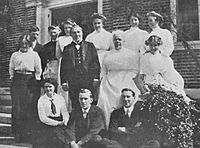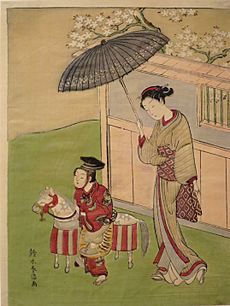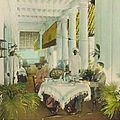Domestic worker facts for kids
A domestic worker is a person who works within the scope of a residence. Many domestic workers live in their employers’ homes. Back in the 19th century, there were many domestic workers in Europe or the United States, as well as in other countries, they would have domestic workers.
A domestic worker is employed by somebody, and therefore domestic workers get paid. They are free to leave their employment if they wish. Many domestic workers are required by their employer to wear a uniform when in their employer's home.
In the Victorian era, Britain had a lot of domestic workers. The butler was the most important one. At meal times he would have been something like a head waiter. Other male domestic workers were often called "valets". A valet (sometimes said with a silent "t") may have been a personal servant who looked after his master’s clothes and comforts, and possibly looked after money matters as well. Female domestic worker were usually maids who cleaned, cooks who prepared the meals and nannies who looked after the children. Gardeners would have done the gardening.
In the early 20th century, new laws were made in Britain to protect domestic workers, and give them more rights. In the early 18th century, even some musicians were servants and had to wear livery (uniform). In 1717, when composer Johann Sebastian Bach said he wanted to leave his job, the duke he worked for put him in prison.
Today in many parts of the world domestic workers from poorer countries are often employed by people in the richer countries.
To ensure the right of decent work for all kind of domestic workers including migrant workers, International Labour Organization has made Convention No. 189 on domestic workers.
Related pages
Images for kids
-
Memorial valuing the work of Maria Home, the servant in Warwick Castle (1834)
-
A Han Dynasty (202 BC – 220 AD) Chinese ceramic figurine of a lady's maid in a standard formal pose with hands covered by long sleeve cuffs in the traditional fashion
-
Child maid servant in India. Child domestic workers are common in India, with the children often being sent by their parents to earn extra money, although it is banned by the government.
-
Alipin (Slaves/Indentured Servants) in Pre-colonial Philippines: Visayan uripon, as depicted in the Boxer Codex (c. 1590)
-
The Chocolate Girl, by Jean-Étienne Liotard (c. 1734–1744)
-
Colonial dining, William Henry Jackson (1895)
See also
 In Spanish: Trabajador doméstico para niños
In Spanish: Trabajador doméstico para niños



















